Ultimate Strategies for Cockroach Control in Rental Properties – Gels, Sprays, Prices, Tips & Best Practices
In the hospitality industry, maintaining a clean and pest-free environment is paramount to ensuring guest satisfaction and preserving the reputation of the establishment. However, one issue that often remains under-discussed is the battle against cockroach infestations. This challenge becomes even more complex when neighboring apartments or units, not under direct control, serve as sources of recurring infestations.
Additionally, new properties taken under management may already harbor hidden infestations, making timely detection and eradication crucial. This article explores effective strategies for promptly addressing and preventing cockroach problems in hospitality settings. To address the cockroach problem, you can consider the following options.
1. Self-Managed Solutions: Using Insecticides for
Rental Apartments and Villas
The self-managed use of insecticides is a practical approach for managing cockroach infestations in rental properties, such as apartments and villas. This method involves property managers or maintenance staff applying insecticides directly to areas where cockroaches are likely to hide and breed. It provides a cost-effective and immediate solution to control pest problems, making it an essential component of a comprehensive pest management strategy.
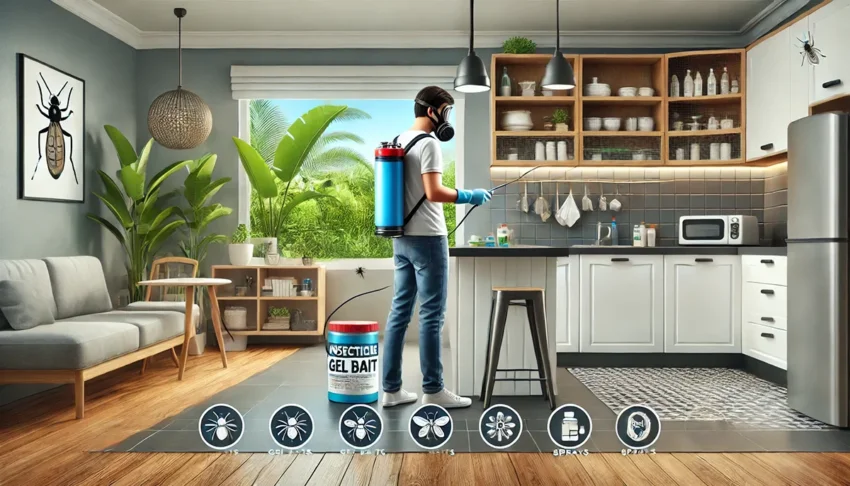
Using Insecticides for Rental Apartments and Villas
Understanding the proper use of insecticides, their benefits, and limitations can help property managers maintain a pest-free environment and ensure the comfort and satisfaction of tenants and guests.
Benefits of Self-Managed Use of Insecticides
- Targeted Application: Allows for precise targeting of cockroach hotspots, such as kitchens, bathrooms, and dark crevices. This ensures that the insecticides are applied where they are most needed, reducing the overall amount of chemicals used.
- Immediate Results: Application can provide quick relief from cockroach infestations, making it an ideal solution for immediate pest control needs.
- Cost-Effective: Compared to professional fumigation, the use of insecticides is generally more affordable, making it accessible for smaller properties or those with budget constraints.
Process of Using Insecticides
- Initial Inspection: Begin with a thorough inspection of the property to identify areas with high cockroach activity. Look for signs such as droppings, egg cases, and live insects to determine the hotspots.
- Selection of Insecticides: Choose the appropriate type of insecticide based on the severity of the infestation and the specific areas to be treated. Common insecticides include sprays, gels, baits, and dusts. Products like Advion Cockroach Gel and Combat Max Roach Killing Bait are widely used for their effectiveness.
- Application Techniques:
- Sprays: Use residual sprays in cracks, crevices, and along baseboards where cockroaches are likely to travel. Ensure that the spray reaches hidden areas to maximize effectiveness.
- Gels and Baits: Apply gels and baits in areas where cockroaches forage for food, such as kitchen cabinets, under sinks, and near trash bins. These products attract cockroaches, which then consume the bait and spread the poison to other members of their colony.
- Dusts: Apply insecticidal dusts in wall voids, behind appliances, and other hard-to-reach places. Dusts can provide long-lasting protection as they remain effective for extended periods.
Safety and Precautions
- Personal Protective Equipment (PPE): Wear appropriate PPE, such as gloves and masks, when applying insecticides to protect yourself from exposure to chemicals.
- Ventilation: Ensure good ventilation during and after application to avoid inhaling fumes. Open windows and use fans to circulate air.
- Proper Storage: Store insecticides safely, away from children and pets, and follow the manufacturer’s instructions for disposal of any unused product.
Pros and Cons
Pros:
- Cost-Effective: Generally more affordable than professional fumigation.
- Immediate Results: Provides quick relief from infestations.
- Targeted Application: Allows for precise control in specific areas.
Cons:
- Limited Scope: May not be as effective for severe or widespread infestations.
- Labor-Intensive: Requires regular application and monitoring.
- Chemical Exposure: Potential risk of exposure to harmful chemicals if not handled properly.
Costs
- Dominican Republic: The cost of insecticides for self-managed application ranges from $10 to $50 per product, depending on the type and brand.
- United States: In the US, prices range from $15 to $100 per product, with more specialized or larger quantities costing more. The overall expense will depend on the size of the property and the extent of the infestation.
Comparative Table of Using Insecticides for Preventing Cockroach Infestations in Rental Properties
| Method | Effectiveness | Cost | Comments |
|---|---|---|---|
| Initial Inspection | High | Low | Identifies infestation hotspots |
| Sprays | Medium | Low-Medium | Effective for surface treatment and immediate results |
| Gels and Baits | High | Low-Medium | Targeted application attracts and kills cockroaches |
| Dusts | High | Medium | Provides long-lasting protection in hard-to-reach areas |
| Personal Protective Equipment (PPE) | High | Low | Ensures safety during application |
| Regular Monitoring | Medium | Low | Essential for maintaining control and preventing re-infestation |
Conclusion
The self-managed use of insecticides by property managers or maintenance staff is a practical and cost-effective method for managing cockroach infestations in rental apartments and villas. By targeting specific areas with sprays, gels, baits, and dusts, property managers can achieve immediate and effective pest control.
While this approach may require regular application and monitoring, it offers a valuable solution for maintaining a pest-free environment. Combining the use of insecticides with other preventive measures and regular inspections can ensure long-term protection and enhance the living experience for tenants and guests.
2. Most Effective Active Ingredients
in Cockroach Gel Baits
Cockroach gel baits are a highly effective method for controlling cockroach infestations. They contain potent active ingredients designed to attract and kill cockroaches. Understanding the different active ingredients can help in selecting the most effective product for your needs. Below are some of the most effective active ingredients commonly found in cockroach gel baits.
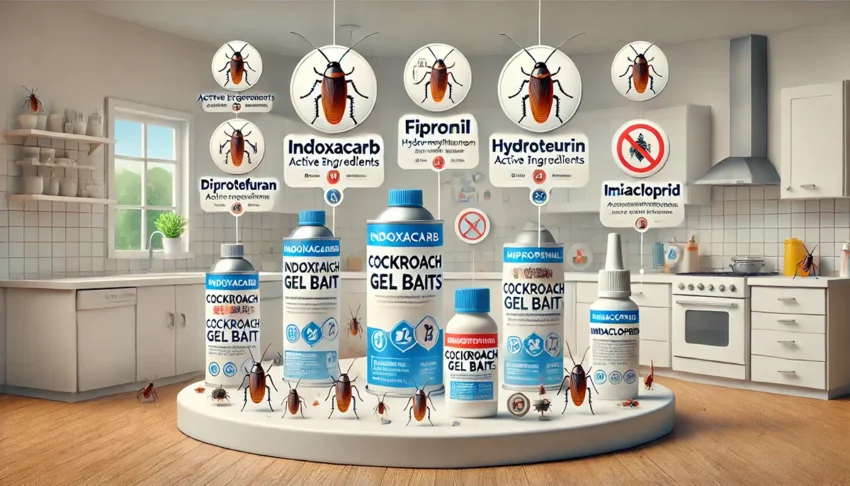
Active Ingredients in Cockroach Gel Baits
Most Effective Active Ingredients
- Fipronil
- How it Works: Fipronil disrupts the central nervous system of cockroaches by blocking the gamma-aminobutyric acid (GABA) receptors, leading to death.
- Effectiveness: Highly effective, works on contact and ingestion, and can kill cockroaches within 24-48 hours.
- Common Products: Advion Cockroach Gel Bait, Maxforce FC Roach Gel
- Hydramethylnon
- How it Works: Hydramethylnon is a slow-acting stomach poison that disrupts the energy production process in cockroaches, leading to death after ingestion.
- Effectiveness: Effective, with a delayed action that allows cockroaches to return to their nests and spread the poison.
- Common Products: Combat Source Kill Max Roach Killing Gel
- Indoxacarb
- How it Works: Indoxacarb is a pro-insecticide that becomes toxic only after ingestion, blocking sodium channels in the cockroach’s nervous system.
- Effectiveness: Very effective, particularly in bait formulations, with cockroaches dying within a few days.
- Common Products: Advion Evolution Cockroach Gel Bait
- Imidacloprid
- How it Works: Imidacloprid acts on the nervous system of cockroaches, causing paralysis and death. It mimics the action of nicotine on insect nerve cells.
- Effectiveness: Effective, especially when combined with other active ingredients.
- Common Products: Premise Cockroach Gel Bait
- Dinotefuran
- How it Works: Dinotefuran interferes with the cockroach’s nervous system by binding to nicotinic acetylcholine receptors, causing hyperactivity and death.
- Effectiveness: Fast-acting and effective, particularly useful in areas with high infestation levels.
- Common Products: Alpine Cockroach Gel Bait
Comparative Table of Active Ingredients in Cockroach Gel Baits
| Active Ingredient | Mechanism of Action | Effectiveness | Common Products | Time to Kill |
|---|---|---|---|---|
| Fipronil | Disrupts central nervous system by blocking GABA receptors | Highly effective | Advion Cockroach Gel, Maxforce FC Gel | 24-48 hours |
| Hydramethylnon | Stomach poison disrupting energy production | Effective, slow-acting | Combat Source Kill Max Gel | Several days |
| Indoxacarb | Blocks sodium channels in nervous system | Very effective | Advion Evolution Gel | Few days |
| Imidacloprid | Mimics nicotine, causing paralysis | Effective | Premise Cockroach Gel | 1-3 days |
| Dinotefuran | Binds to nicotinic acetylcholine receptors | Fast-acting, effective | Alpine Cockroach Gel | Hours to a few days |
Conclusion
Choosing the right cockroach gel bait depends on understanding the active ingredients and their mechanisms of action. Fipronil and Indoxacarb are among the most highly effective, offering quick results, while Hydramethylnon provides a slower, but effective, method that allows the poison to spread through cockroach nests.
Imidacloprid and Dinotefuran offer additional options with unique mechanisms and fast action. Using these insights, property managers can select the best products to maintain a pest-free environment in rental apartments and villas.
3. The Most Effective Cockroach
Gel Bait Products
Understanding the active ingredients in cockroach gel baits is essential for selecting the most effective product. Below is a detailed overview of specific products based on their active ingredients, listed in order of effectiveness. This will help property managers choose the best options for controlling cockroach infestations in rental apartments and villas.

Effective Cockroach Gel Bait Products
1. Advion Cockroach Gel Bait
- Active Ingredient: Indoxacarb
- How it Works: Indoxacarb becomes toxic only after ingestion, blocking sodium channels in the cockroach’s nervous system.
- Effectiveness: Highly effective, kills within a few days, and is particularly good for large infestations.
- Pros: Quick action, easy application, widely trusted.
- Cons: Requires reapplication for severe infestations.
- Price: $30-$40 for a 30-gram tube.
2. Maxforce FC Roach Gel
- Active Ingredient: Fipronil
- How it Works: Fipronil disrupts the central nervous system of cockroaches by blocking GABA receptors.
- Effectiveness: Highly effective, works within 24-48 hours.
- Pros: Fast-acting, strong residual effect.
- Cons: Can be more expensive than other gels.
- Price: $35-$45 for a 30-gram tube.
3. Combat Source Kill Max Roach Killing Gel
- Active Ingredient: Hydramethylnon
- How it Works: Hydramethylnon disrupts energy production in cockroaches, leading to death after ingestion.
- Effectiveness: Effective, with delayed action that allows the poison to spread.
- Pros: Long-lasting, allows for extensive spread within nests.
- Cons: Slower to kill compared to Fipronil and Indoxacarb.
- Price: $10-$20 for a 30-gram tube.
4. Alpine Cockroach Gel Bait
- Active Ingredient: Dinotefuran
- How it Works: Dinotefuran interferes with the nervous system by binding to nicotinic acetylcholine receptors.
- Effectiveness: Fast-acting and effective, particularly useful in areas with high infestation levels.
- Pros: Effective in killing a wide range of cockroach species, quick results.
- Cons: May require frequent reapplication in high infestation areas.
- Price: $20-$30 for a 30-gram tube.
5. Premise Cockroach Gel Bait
- Active Ingredient: Imidacloprid
- How it Works: Imidacloprid acts on the nervous system of cockroaches, causing paralysis and death.
- Effectiveness: Effective, especially when combined with other active ingredients.
- Pros: Works well in combination with other treatments, easy to apply.
- Cons: Not as fast-acting as Fipronil or Indoxacarb.
- Price: $25-$35 for a 30-gram tube.
Comparative Table of Cockroach Gel Baits
| Product | Active Ingredient | Mechanism of Action | Effectiveness | Pros | Cons | Price (USD) |
|---|---|---|---|---|---|---|
| Advion Cockroach Gel Bait | Indoxacarb | Blocks sodium channels in the nervous system | Highly effective | Quick action, easy application, widely trusted | Requires reapplication for severe infestations | $30-$40 per 30g tube |
| Maxforce FC Roach Gel | Fipronil | Disrupts central nervous system | Highly effective | Fast-acting, strong residual effect | Can be more expensive | $35-$45 per 30g tube |
| Combat Source Kill Max Roach Gel | Hydramethylnon | Disrupts energy production | Effective, slow-acting | Long-lasting, extensive spread within nests | Slower to kill | $10-$20 per 30g tube |
| Alpine Cockroach Gel Bait | Dinotefuran | Interferes with nicotinic acetylcholine receptors | Fast-acting, effective | Kills a wide range of species, quick results | May require frequent reapplication | $20-$30 per 30g tube |
| Premise Cockroach Gel Bait | Imidacloprid | Causes paralysis by acting on the nervous system | Effective | Works well with other treatments, easy to apply | Not as fast-acting as Fipronil or Indoxacarb | $25-$35 per 30g tube |
Conclusion
Choosing the right cockroach gel bait depends on understanding the active ingredients and their mechanisms of action. Advion Cockroach Gel Bait with Indoxacarb and Maxforce FC Roach Gel with Fipronil are among the most effective, offering quick results and strong residual effects. Combat Source Kill Max Roach Killing Gel with Hydramethylnon provides a slower but effective method that allows the poison to spread through cockroach nests.
Alpine Cockroach Gel Bait with Dinotefuran and Premise Cockroach Gel Bait with Imidacloprid offer additional options with unique mechanisms and fast action. Using these insights, property managers can select the best products to maintain a pest-free environment in rental apartments and villas.
4. Importance of Secondary Poisoning
in Cockroach Control
Secondary poisoning, also known as horizontal transfer or secondary kill, is a crucial aspect of effective cockroach control. This occurs when cockroaches that have ingested poison return to their nests and transfer the poison to other cockroaches through contact, grooming, or consumption of feces and carcasses.
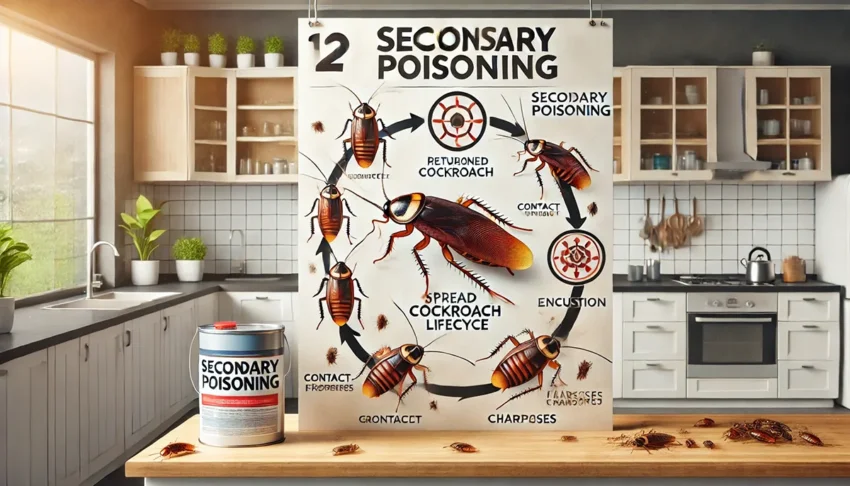
Secondary Poisoning in Cockroach Control
This mechanism significantly enhances the effectiveness of pest control efforts by ensuring that not only the cockroaches that directly consume the bait are killed, but also those in their vicinity. Understanding and utilizing products that facilitate secondary poisoning can lead to more comprehensive and long-lasting control of cockroach infestations.
How Secondary Poisoning Works
- Ingestion of Poison: Cockroaches consume the bait that contains a slow-acting insecticide.
- Return to Nest: The poisoned cockroaches return to their nest before dying, carrying the toxic substance with them.
- Transfer of Poison: The poison spreads to other cockroaches through grooming, contact, or consumption of contaminated feces and carcasses.
- Secondary Deaths: Cockroaches that did not directly consume the bait die after coming into contact with the poisoned individuals, significantly reducing the population.
Most Effective Products for Secondary Poisoning
- Advion Cockroach Gel Bait
- Active Ingredient: Indoxacarb
- Effectiveness for Secondary Poisoning: Very high. Indoxacarb is particularly effective for secondary poisoning because it remains active in the dead bodies and feces of cockroaches, allowing the poison to spread through the colony.
- Price: $30-$40 for a 30-gram tube.
- Maxforce FC Roach Gel
- Active Ingredient: Fipronil
- Effectiveness for Secondary Poisoning: High. Fipronil is known for its ability to cause secondary poisoning as it disrupts the central nervous system of cockroaches, leading to effective horizontal transfer within the colony.
- Price: $35-$45 for a 30-gram tube.
- Combat Source Kill Max Roach Killing Gel
- Active Ingredient: Hydramethylnon
- Effectiveness for Secondary Poisoning: Moderate. Hydramethylnon works by disrupting energy production in cockroaches, and while it does facilitate some secondary poisoning, it is less effective than Indoxacarb and Fipronil in this regard.
- Price: $10-$20 for a 30-gram tube.
- Alpine Cockroach Gel Bait
- Active Ingredient: Dinotefuran
- Effectiveness for Secondary Poisoning: High. Dinotefuran is fast-acting and effective for secondary poisoning as it binds to nicotinic acetylcholine receptors, leading to rapid secondary deaths.
- Price: $20-$30 for a 30-gram tube.
- Premise Cockroach Gel Bait
- Active Ingredient: Imidacloprid
- Effectiveness for Secondary Poisoning: High. Imidacloprid is effective for secondary poisoning as it causes paralysis and death, which can be transferred to other cockroaches through contact.
- Price: $25-$35 for a 30-gram tube.
- Boric Acid
- Active Ingredient: Boric Acid
- Effectiveness for Secondary Poisoning: High. Boric acid is an effective and economical option for cockroach control. When ingested, it disrupts the cockroach’s digestive system and can be transferred to other cockroaches through feces and carcasses.
- Price: $5-$15 per pound.
Effectiveness of Sprays for Cockroach Control
Sprays can provide immediate knockdown of visible cockroaches but are generally less effective for long-term control and secondary poisoning. They work primarily by direct contact or through residual action when sprayed on surfaces. However, sprays do not reach deep into cockroach nests and do not facilitate secondary poisoning, making them less effective for comprehensive and lasting control of infestations.
- Pros:
- Immediate reduction in visible cockroach population.
- Easy to apply in accessible areas.
- Cons:
- Limited effectiveness in reaching hidden nests.
- No secondary poisoning effect, requiring frequent reapplication.
- Less effective for long-term control compared to baits and gels.
Comparative Table of Cockroach Control Products for Secondary Poisoning
| Product | Active Ingredient | Effectiveness for Secondary Poisoning | Price (USD) |
|---|---|---|---|
| Advion Cockroach Gel Bait | Indoxacarb | Very High | $30-$40 per 30g tube |
| Maxforce FC Roach Gel | Fipronil | High | $35-$45 per 30g tube |
| Combat Source Kill Max Roach Gel | Hydramethylnon | Moderate | $10-$20 per 30g tube |
| Alpine Cockroach Gel Bait | Dinotefuran | High | $20-$30 per 30g tube |
| Premise Cockroach Gel Bait | Imidacloprid | High | $25-$35 per 30g tube |
| Boric Acid | Boric Acid | High | $5-$15 per pound |
| Sprays | Various | Low | $5-$20 per can |
Conclusion
Secondary poisoning significantly enhances the effectiveness of cockroach control efforts by ensuring that the poison spreads throughout the cockroach population, not just those that directly consume the bait. Products like Advion Cockroach Gel Bait and Maxforce FC Roach Gel are particularly effective for this purpose due to their potent active ingredients, Indoxacarb and Fipronil, respectively.
While Hydramethylnon in Combat Source Kill Max Roach Gel provides moderate secondary poisoning effects, products with Dinotefuran and Imidacloprid, such as Alpine and Premise Cockroach Gel Baits, also offer high effectiveness in secondary poisoning. Boric acid is an economical and effective option that works through ingestion and secondary transfer.
On the other hand, sprays are less effective for long-term control and secondary poisoning, making them more suitable for immediate knockdown rather than comprehensive pest management. Understanding these differences can help property managers choose the most effective solutions for maintaining a pest-free environment in rental apartments and villas.
5. Safety of Using Insecticides in
Tropical and Hot Climates
Using insecticides in tropical and hot climates, such as those found in the Dominican Republic and other similar regions, requires special consideration due to the high temperatures and humidity. Proper application and storage of insecticides are essential to ensure their effectiveness and the safety of residents and applicators. Here are key points to consider when using insecticides in these environments.
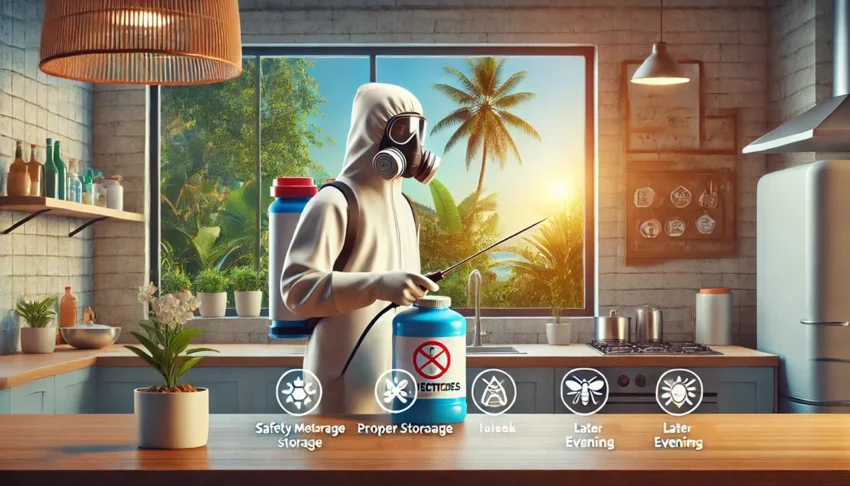
Safety of Using Insecticides
Considerations for Safety
- Heat Stability of Insecticides:
- Many insecticides are sensitive to high temperatures and can degrade if not stored properly. Always check the manufacturer’s guidelines for storage conditions.
- Keep insecticides in a cool, dry place away from direct sunlight to maintain their efficacy.
- Proper Ventilation:
- High temperatures can cause insecticides to volatilize more quickly, increasing the risk of inhalation. Ensure that the area is well-ventilated during and after application.
- Use fans and open windows to circulate air and reduce the concentration of insecticides in the air.
- Personal Protective Equipment (PPE):
- Wearing appropriate PPE is crucial in hot climates to protect against exposure. Use gloves, masks, and long-sleeved clothing to prevent skin contact and inhalation.
- Consider the heat stress that PPE might cause; work in cooler parts of the day and take frequent breaks.
- Application Timing:
- Apply insecticides during the cooler parts of the day, such as early morning or late evening, to reduce the risk of volatilization and evaporation.
- Avoid application during the hottest parts of the day to prevent rapid evaporation and reduced effectiveness.
- Residue Management:
- In tropical climates, higher humidity can affect the residual activity of insecticides. Ensure that the surfaces remain dry after application to maintain efficacy.
- Regularly check and reapply insecticides as necessary to ensure continuous control.
- Safe Handling and Storage:
- Store insecticides in sealed containers to prevent contamination and degradation from heat and humidity.
- Ensure that storage areas are secure and out of reach of children and pets.
Specific Insecticides and Safety Measures
- Indoxacarb:
- Safety in Tropical Climates: Stable under high temperatures if stored properly. Ensure the gel is applied in cool, shaded areas to maintain its efficacy.
- Storage: Keep in a cool, dry place away from direct sunlight.
- Fipronil:
- Safety in Tropical Climates: Effective in high temperatures, but ensure proper ventilation during application to prevent inhalation.
- Storage: Store in a cool, dry environment.
- Hydramethylnon:
- Safety in Tropical Climates: Effective but can degrade if exposed to high heat and humidity for prolonged periods. Apply in shaded, cooler areas.
- Storage: Store in a cool, dry place.
- Dinotefuran:
- Safety in Tropical Climates: Stable in high temperatures but should be kept out of direct sunlight during application.
- Storage: Keep in a cool, dry location.
- Imidacloprid:
- Safety in Tropical Climates: Effective under high temperatures, but ensure good ventilation during application.
- Storage: Store in a cool, dry area.
- Boric Acid:
- Safety in Tropical Climates: Highly stable and effective in hot climates. Ensure that application areas remain dry for maximum effectiveness.
- Storage: Store in a dry place, as moisture can reduce its efficacy.
- Sprays:
- Safety in Tropical Climates: Use with caution as sprays can volatilize quickly in high heat, increasing the risk of inhalation. Ensure good ventilation and avoid application during the hottest part of the day.
- Storage: Keep in a cool, shaded area to prevent degradation.
Summary
When using insecticides in tropical and hot climates, it is crucial to consider the stability and effectiveness of the products under high temperatures and humidity. Proper storage, application timing, and use of personal protective equipment are essential to ensure the safety of both residents and applicators. By following these guidelines, property managers can effectively control cockroach infestations while maintaining a safe environment for everyone involved.
6. Sprays for Cockroach Control
Sprays are a common choice for controlling cockroach infestations, offering immediate knockdown of visible pests. However, their long-term effectiveness and safety compared to gel baits vary significantly. Understanding the active ingredients in sprays, their mechanisms of action, and their safety profiles can help property managers make informed decisions for pest control in rental apartments and villas.
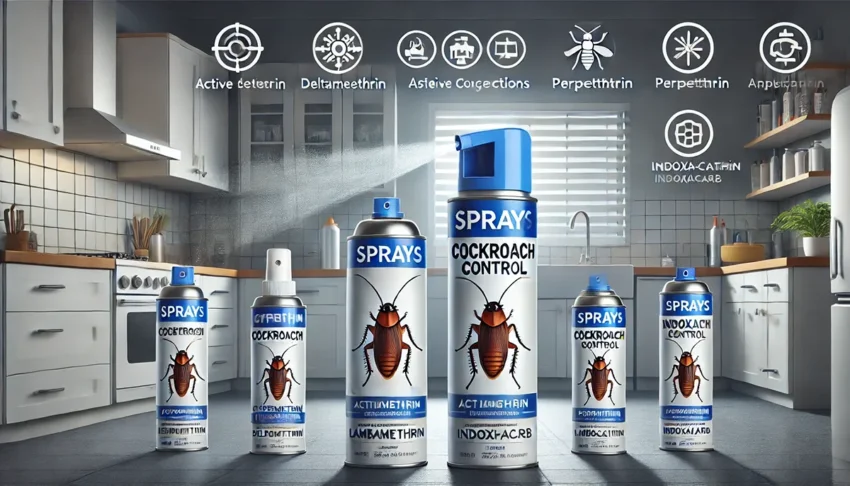
Sprays for Cockroach Control
Active Ingredients in Sprays and Their Effectiveness
- Cypermethrin
- Mechanism of Action: Cypermethrin is a synthetic pyrethroid that affects the nervous system of cockroaches, leading to paralysis and death.
- Effectiveness: Provides immediate knockdown of cockroaches upon contact. It has a moderate residual effect, lasting for a few weeks.
- Long-Term Effectiveness: Less effective for long-term control as it requires frequent reapplication and does not facilitate secondary poisoning.
- Deltamethrin
- Mechanism of Action: Another synthetic pyrethroid, deltamethrin works by disrupting the normal functioning of the nervous system.
- Effectiveness: Highly effective for immediate knockdown and has a residual effect lasting up to a few months.
- Long-Term Effectiveness: While effective in the short term, deltamethrin’s effectiveness diminishes over time, requiring periodic reapplication.
- Permethrin
- Mechanism of Action: Permethrin interferes with the sodium channels of the nervous system, causing paralysis and death.
- Effectiveness: Effective for immediate and short-term control, with residual effects lasting a few weeks.
- Long-Term Effectiveness: Requires frequent reapplication for sustained control, and like other pyrethroids, it does not support secondary poisoning.
- Lambda-Cyhalothrin
- Mechanism of Action: Lambda-cyhalothrin is a synthetic pyrethroid that disrupts the nervous system of insects.
- Effectiveness: Provides rapid knockdown and has residual activity lasting several weeks.
- Long-Term Effectiveness: Effective in the short term but requires regular reapplication to maintain control.
- Indoxacarb (in spray form)
- Mechanism of Action: Indoxacarb becomes toxic after ingestion, disrupting the nervous system.
- Effectiveness: Effective for both immediate and residual control, with effects lasting several weeks.
- Long-Term Effectiveness: More effective than other sprays due to its residual activity and potential for secondary poisoning.
Safety Comparison: Sprays vs. Gels
- Sprays:
- Safety Profile: Sprays can pose a higher risk of inhalation and skin contact, especially during application. Proper ventilation and personal protective equipment (PPE) are essential.
- Residue: Sprays can leave residues on surfaces that may be harmful if contacted by children or pets.
- Effectiveness: Sprays are less effective for long-term control due to their need for frequent reapplication and lack of secondary poisoning.
- Gels:
- Safety Profile: Gels are generally safer to apply as they are placed in targeted locations, reducing the risk of exposure. They do not aerosolize, minimizing inhalation risks.
- Residue: Gels remain in place, reducing the risk of accidental contact with humans and pets.
- Effectiveness: Gels are more effective for long-term control due to their ability to facilitate secondary poisoning and their longer-lasting residual effects.
Comparative Table: Sprays vs. Gels for Cockroach Control
| Feature | Sprays | Gels |
|---|---|---|
| Active Ingredients | Cypermethrin, Deltamethrin, Permethrin, Lambda-Cyhalothrin, Indoxacarb | Indoxacarb, Fipronil, Hydramethylnon, Dinotefuran, Imidacloprid, Boric Acid |
| Immediate Knockdown | High | Moderate |
| Residual Effectiveness | Moderate (weeks to a few months) | High (weeks to months) |
| Secondary Poisoning | Low | High |
| Safety Profile (Application) | Higher risk of inhalation and skin contact | Lower risk, targeted application |
| Safety Profile (Post-Application) | Potential residue hazards | Lower residue risks |
| Reapplication Frequency | Frequent | Less frequent |
| Long-Term Effectiveness | Moderate | High |
Conclusion
Sprays offer immediate knockdown of visible cockroaches and provide short-term control, but they require frequent reapplication and do not support secondary poisoning. This makes them less effective for long-term pest management compared to gels. The active ingredients in sprays, such as cypermethrin, deltamethrin, permethrin, lambda-cyhalothrin, and indoxacarb, provide varying levels of effectiveness and safety.
Gels, on the other hand, are more effective for long-term control due to their residual activity and ability to facilitate secondary poisoning. They are also generally safer to apply and pose fewer risks post-application. Understanding these differences can help property managers choose the most suitable and effective solutions for maintaining a pest-free environment in rental apartments and villas.
7. Professional Fumigation
for Vacation Rentals
Professional fumigation is a critical component of pest management for rental properties, particularly apartments and villas. Cockroach infestations can severely impact the comfort and health of tenants and guests, and addressing them promptly and effectively is crucial for property managers.

Professional Fumigation for Vacation Rentals
In the Dominican Republic, where the warm, humid climate is ideal for pests, professional fumigation services are particularly essential. Similarly, in the United States, ensuring a pest-free environment in rental properties is vital for maintaining high occupancy rates and tenant satisfaction.
This method involves the use of specialized chemicals and equipment to eliminate cockroach infestations thoroughly and effectively. By engaging professional pest control services, property managers can ensure that their properties remain pest-free, enhancing the living experience for tenants and guests and maintaining the property’s value and reputation.
Benefits of Professional Fumigation
- Comprehensive Treatment: Professional fumigation provides a thorough treatment that penetrates all areas of the property, including hard-to-reach places where cockroaches often hide. This ensures that both visible and hidden infestations are addressed, offering a more complete solution than over-the-counter treatments.
- Expert Knowledge: Professional exterminators have the expertise and knowledge to identify the specific type of cockroach infestation and apply the most effective treatment methods. They can tailor their approach to the unique needs of each property, ensuring maximum efficacy.
Process of Professional Fumigation
- Initial Inspection: The fumigation process begins with a detailed inspection of the property to assess the extent of the infestation. Pest control professionals identify the species of cockroach, the severity of the problem, and the areas that require treatment.
- Preparation: Before fumigation, tenants and guests are usually required to vacate the premises. The property is then sealed to ensure that the fumigant remains contained within the treated areas, maximizing its effectiveness. This preparation also includes securing food items and personal belongings to prevent contamination.
- Application of Fumigant: The fumigant is introduced into the property using specialized equipment. Commonly used fumigants include sulfuryl fluoride (e.g., Vikane) and methyl bromide. These chemicals penetrate all areas, including cracks, crevices, and behind walls, to eliminate cockroaches at all stages of their lifecycle. The fumigation process typically takes several hours to complete, depending on the size and layout of the property.
- Post-Treatment Ventilation: After the fumigation period, the property is ventilated to remove any residual chemicals. Professionals use air blowers and fans to ensure that the fumigant is thoroughly dissipated, making the property safe for re-entry. This ventilation process usually takes a few hours.
- Final Inspection and Clean-Up: A final inspection is conducted to ensure that the fumigation was successful and that no cockroaches remain. Any dead pests are removed, and the property is cleaned and restored to its normal condition.
Speed and Re-Entry
- Duration: The entire fumigation process, including preparation, application, and ventilation, typically takes 24-48 hours.
- Re-Entry: Guests and tenants can usually return to the property 24-48 hours after fumigation, once the professionals confirm that the property is safe and all residual chemicals have dissipated.
Equipment and Safety
- Specialized Equipment: Professionals use gas masks, protective suits, and specialized fumigation equipment to safely apply and ventilate the fumigants.
- Safety Measures: Proper safety protocols are followed to ensure the safety of both the fumigation team and the property’s occupants. This includes sealing the property, monitoring gas levels, and ensuring thorough ventilation.
Pros and Cons
- Pros:
- Thorough and Comprehensive: Penetrates all areas, including hidden spots.
- Effective: Eliminates all stages of cockroaches, ensuring a high success rate.
- Professional Expertise: Ensures proper application and safety measures.
- Cons:
- Cost: Professional fumigation can be expensive.
- Inconvenience: Requires occupants to vacate the property temporarily.
- Chemical Use: Involves the use of toxic chemicals that require careful handling.
Costs
- Dominican Republic: The cost of professional fumigation services in the Dominican Republic typically ranges from $200 to $600, depending on the size of the property and the severity of the infestation.
- United States: In the US, costs generally range from $500 to $2,000, with larger properties and severe infestations costing more. Prices can vary based on location, the extent of the infestation, and the specific pest control company.
Comparative Table of Professional Fumigation for Preventing Cockroach Infestations in Rental Properties
| Method | Effectiveness | Cost | Comments |
|---|---|---|---|
| Initial Inspection | High | Medium | Identifies the extent of the infestation and specific treatment needs |
| Preparation | High | Low | Ensures safety and maximizes the effectiveness of the fumigant |
| Application of Fumigant | High | High | Provides thorough penetration to eliminate all stages of cockroaches |
| Post-Treatment Ventilation | High | Low | Ensures the property is safe for re-entry |
| Final Inspection and Clean-Up | High | Medium | Confirms the success of the treatment and restores the property |
| Regular Follow-Ups | High | Medium | Maintains effectiveness and prevents future infestations |
| Preventive Measures | High | Low | Reduces the risk of reinfestation and supports long-term control |
Conclusion
Professional fumigation is an essential measure for effectively managing and eliminating cockroach infestations in rental apartments and villas. This method offers a comprehensive solution that addresses both visible and hidden pests, ensuring a thorough and lasting treatment.
By combining professional expertise with regular follow-ups and preventive measures, property managers can maintain a pest-free environment, enhancing the quality and reputation of their rental properties. This integrated approach ensures long-term protection and peace of mind for both property managers and tenants.
8. Effectiveness of Ultrasonic
Cockroach Repellents
Overview and Scientific Studies
Ultrasonic repellents operate on the principle of emitting high-frequency sound waves that are inaudible to humans but are supposed to repel insects and rodents. However, scientific studies and reviews show mixed results regarding their effectiveness.
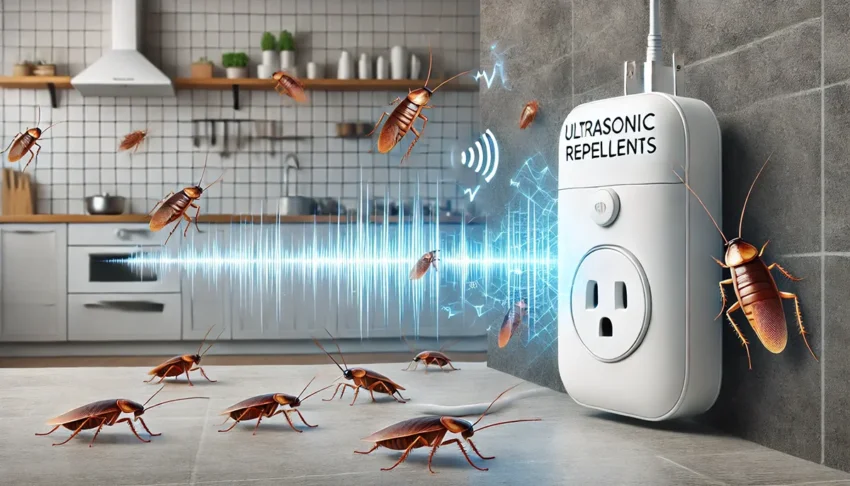
Ultrasonic Cockroach Repellents
Scientific Data:
- Kansas State University (2002): Studies indicated that ultrasonic devices were not effective in repelling ants and other insects in both laboratory and field conditions. Link to study
- University of Arizona: A review of studies revealed that the success of the devices is associated with the development of specialized devices rather than widely available commercial models. Link to review
- State University of Campinas, Brazil (2010): Some mosquito repelling devices even increased the number of bites. Link to study
Practical Observations:
- Expert Opinion: Many pest control experts believe that ultrasonic repellents cannot be the sole solution to the problem. They recommend using them in combination with other pest control methods, such as sealing cracks and eliminating food sources.
- User Reviews: User opinions on platforms like Amazon vary, with some positive reviews, but most acknowledging that the effect is insufficient for a long-term solution.
Device Rating Table
| Device | Effectiveness | Price ($) | Comments |
|---|---|---|---|
| T3-R Triple High Impact Repeller | Medium | 35-40 | Most effective for rodents |
| Neatmaster Ultrasonic Repeller | Medium | 20-25 | Good reviews, but limited effectiveness |
| Pest Repeller Ultimate AT | Low | 15-20 | Often obstructed by furniture |
| Careland Solar-Powered Repeller | Low | 25-30 | Limited effectiveness in open spaces |
Conclusion
While ultrasonic repellents may provide temporary relief, scientific data and expert opinions indicate that they are not a reliable solution to the cockroach problem. It is recommended to use these devices in combination with traditional pest control methods for better results.
9. Effectiveness of Natural
Cockroach Repellents
Overview and Scientific Studies
Natural repellents, such as essential oils, operate on the principle of emitting scents that are unpleasant to insects, thereby driving them away. However, scientific studies and user reviews show mixed results regarding their effectiveness.
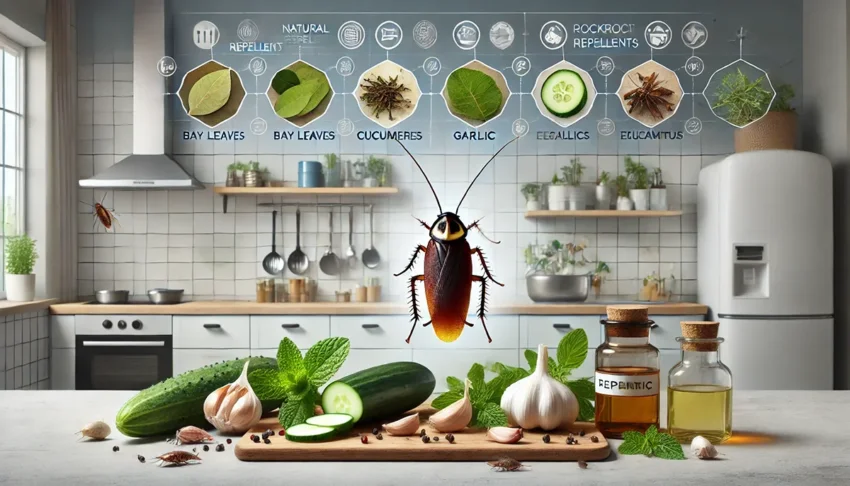
Natural Cockroach Repellents
Scientific Data:
- Auburn University (2014): Studies indicated that essential oils like peppermint and eucalyptus can repel cockroaches, but their effectiveness diminishes over time. Link to study
- University of California, Riverside: Research revealed that while some natural repellents can deter cockroaches, they are not as effective as chemical insecticides. Link to review
- National Institute of Health (2017): Some essential oils showed promise in repelling various pests, but their efficacy depends on concentration and application method. Link to study
Practical Observations:
- Expert Opinion: Many pest control experts believe that natural repellents alone are insufficient for long-term cockroach control. They recommend using them in combination with other methods, such as sealing cracks and regular cleaning.
- User Reviews: Opinions on platforms like Amazon vary, with some users reporting success, but many acknowledging that the effect is short-lived and insufficient for serious infestations.
Natural Repellent Rating Table
| Repellent | Effectiveness | Price ($) | Comments |
|---|---|---|---|
| Peppermint Oil Spray | Medium | 10-15 | Effective in the short term, needs frequent reapplication |
| Eucalyptus Oil | Medium | 8-12 | Good reviews, but limited effectiveness over time |
| Lavender Oil | Low | 7-10 | Pleasant smell, but not very effective for cockroaches |
| Tea Tree Oil | Low | 9-13 | Limited effectiveness, better for other insects |
Conclusion
While natural repellents such as essential oils can provide temporary relief, scientific data and expert opinions indicate that they are not a reliable solution to a cockroach problem on their own. It is recommended to use these natural products in combination with traditional pest control methods, such as sealing entry points and maintaining cleanliness, for better results.
10. Sanitary Measures for Rental
Apartments and Villas
Maintaining a clean and hygienic environment is crucial for rental properties, especially apartments and villas, to prevent and control cockroach infestations. Sanitary measures not only enhance the living experience for tenants and guests but also protect the property’s reputation and value. Focusing on eliminating food sources, reducing moisture levels, and maintaining overall cleanliness are essential strategies for making your rental property less attractive to cockroaches.

Sanitary Measures for Rental Apartments and Villas
Regular Cleaning
- Frequent Cleaning: Regularly clean all areas of the property, especially kitchens, bathrooms, and dining areas. Cleaning should include wiping down countertops, sweeping and mopping floors, and cleaning under appliances to remove food crumbs and spills. Ensure that cleaning staff are trained and follow a strict cleaning schedule.
- Trash Management: Provide trash bins with tight-fitting lids and ensure regular disposal of garbage. Use durable trash bags to prevent tears and leaks, which can attract cockroaches. Encourage tenants to follow proper waste disposal practices.
Proper Food Storage
- Sealed Containers: Ensure that food provided for guests is stored in airtight containers to prevent access to food sources. This includes dry goods like cereal, flour, and sugar, as well as pet food. Provide guidance for guests to store their food properly.
- Refrigeration: Make sure refrigerators in the units are in good working condition and that guests know to store perishable items in the fridge to reduce the availability of food for cockroaches. Regularly check that refrigerator seals are intact and effective.
Moisture Control
- Fix Leaks: Promptly repair any leaking faucets, pipes, or appliances to eliminate sources of moisture. Cockroaches are attracted to water, and even small leaks can create a suitable environment for them. Regular inspections by maintenance staff can help identify and address these issues quickly.
- Proper Ventilation: Ensure that bathrooms, kitchens, and laundry areas have adequate ventilation to reduce humidity levels. Install exhaust fans where necessary and consider using dehumidifiers in particularly damp areas.
Decluttering
- Remove Clutter: Minimize clutter in living spaces as cockroaches often hide and breed in piles of paper, cardboard, and other debris. Keep storage areas, closets, and basements organized and clean.
- Organized Storage: Use plastic bins with lids instead of cardboard boxes to store items in storage areas. This not only keeps the area tidy but also reduces the number of potential cockroach hiding places.
Regular Inspections
- Routine Checks: Conduct regular inspections of the property to identify and address any potential cockroach problems early. Look for signs of infestation, such as droppings, egg cases, and shed skins, and take immediate action if any are found.
- Professional Pest Control: Schedule regular visits from a professional pest control service to ensure that the property remains cockroach-free. Professional services can provide expert advice and treatments to address any infestations that may occur.
Comparative Table of Sanitary Measures for Preventing Cockroach Infestations in Rental Properties
| Method | Effectiveness | Cost | Comments |
|---|---|---|---|
| Regular Cleaning | High | Low | Essential for removing food crumbs and spills; requires trained staff |
| Trash Management | High | Low | Prevents attraction by securing and promptly disposing of waste |
| Sealed Food Storage | High | Low | Keeps food inaccessible to cockroaches; ensure guest compliance |
| Refrigeration | High | Low | Reduces availability of perishable food sources; regular maintenance needed |
| Fixing Leaks | High | Medium | Eliminates water sources that attract cockroaches; regular inspections required |
| Proper Ventilation | Medium | Medium | Helps control humidity and moisture levels; consider exhaust fans and dehumidifiers |
| Decluttering | Medium | Low | Reduces potential hiding and breeding spots; periodic decluttering essential |
| Organized Storage | Medium | Low | Prevents cockroaches from hiding in storage areas; use plastic bins with lids |
| Routine Inspections | High | Low | Allows early detection and intervention; essential for long-term control |
| Professional Pest Control | High | Medium | Provides expert treatment and advice; ensures thorough pest management |
Conclusion
Implementing comprehensive sanitary measures is critical for rental apartments and villas to prevent cockroach infestations. By focusing on regular cleaning, proper food storage, moisture control, decluttering, and routine inspections, property managers can create an environment that is less attractive to cockroaches.
Combining these sanitary practices with other preventive methods ensures a more effective and long-lasting solution to pest control, thereby enhancing the quality and reputation of the rental property.
11. Preventing Cockroach Entry
Preventing cockroach entry is a crucial step in maintaining a pest-free environment in both residential and commercial properties. Cockroaches can enter buildings through various entry points, including cracks, gaps, and drainage systems, making it essential to implement effective barriers to block their access. This approach not only helps in reducing the immediate presence of these pests but also minimizes the risk of future infestations.
By focusing on methods such as installing mosquito nets, sealing cracks and gaps, and using door sweeps, property owners can create a robust defense against cockroach entry. These preventive measures are cost-effective and environmentally friendly, providing a sustainable solution to the pest problem. Regular maintenance and inspections further ensure that these barriers remain effective over time, offering long-term protection and peace of mind.
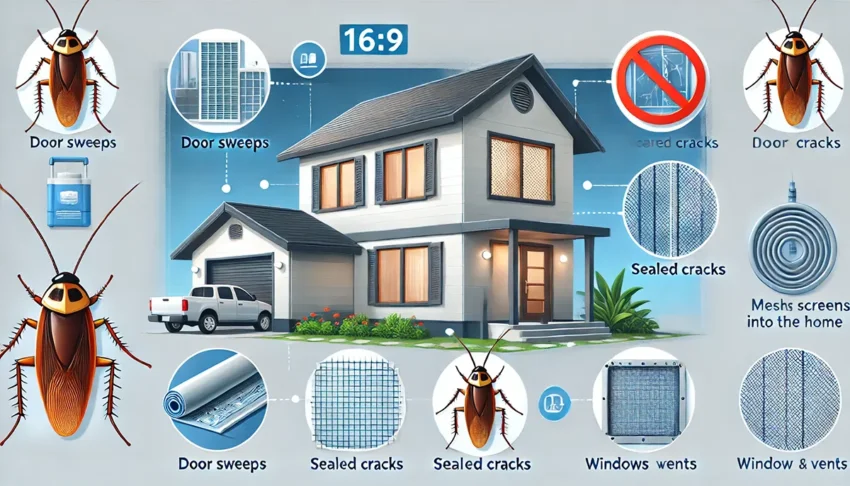
Preventing Cockroach Entry
1. Mosquito Nets and Thresholds
- Mosquito Nets: Installing mosquito nets on windows and doors serves as an effective physical barrier to keep cockroaches out. These nets are especially useful in preventing insects from entering living spaces while allowing for ventilation. Ensure that the nets are fitted tightly without any gaps. They are easy to install and can be purchased in various sizes to fit different window and door dimensions.
- Thresholds: Adding thresholds to doorways can block the small gaps under doors that cockroaches can easily crawl through. Door thresholds should be made of durable materials such as metal or rubber and should be installed flush with the floor to create a seal. They are particularly effective in exterior doors and doors leading to basements or garages.
2. Drain Screens
Placing fine metal screens on drainage outlets is crucial in preventing cockroaches from entering through plumbing systems. Cockroaches can enter homes through sinks, bathtubs, and floor drains. Metal screens with a mesh size of no more than 2 mm can effectively block these entry points while allowing water to flow freely. These screens are especially important in kitchens and bathrooms where food and moisture attract cockroaches.
3. Sealing Cracks and Gaps
Cracks and gaps in walls, floors, and ceilings are common entry points for cockroaches. Using a high-quality sealant to fill these gaps is an effective way to block their access. Pay special attention to areas around baseboards, pipes, electrical outlets, and any other openings. A silicone-based sealant is often recommended for its durability and flexibility. Regularly inspect your home for new cracks and gaps, especially in older buildings, and seal them promptly.
4. Weather Stripping
Applying weather stripping around doors and windows helps seal gaps that can allow cockroaches to enter. This method not only prevents pest entry but also improves energy efficiency by reducing drafts. Weather stripping can be made of foam, rubber, or metal and should be chosen based on the specific needs of your doors and windows. Ensure that the weather stripping is installed properly and check it periodically for wear and tear.
5. Door Sweeps
Installing door sweeps at the bottom of exterior doors effectively closes the gap between the door and the floor, a common entry point for cockroaches. Door sweeps are available in various materials, including vinyl, rubber, and metal. Choose a sweep that fits the width of your door and is flexible enough to create a tight seal. Door sweeps are easy to install and are a cost-effective solution to prevent pests from entering your home.
6. Caulking
Using caulk to seal gaps around pipes, utility openings, and any other potential entry points is essential in preventing cockroach infestations. Caulk can be used to seal gaps in areas where other materials, such as weather stripping, might not be effective. Silicone caulk is ideal for areas that are exposed to moisture, such as kitchens and bathrooms. Apply caulk around sinks, bathtubs, toilets, and any other areas where pipes enter the walls.
7. Regular Maintenance
Regularly inspecting and maintaining all barriers is crucial to ensure their effectiveness. Over time, barriers such as screens, weather stripping, and door sweeps can become damaged or worn out. Regular maintenance includes checking for and repairing any damage, replacing worn-out materials, and ensuring that all seals remain intact. This proactive approach ensures that your pest control measures continue to be effective and that new entry points are addressed promptly.
Comparative Table of Methods for Preventing Cockroach Entry
| Method | Effectiveness | Cost | Comments |
|---|---|---|---|
| Mosquito Nets | High | Low | Effective barrier for windows and doors |
| Thresholds | Medium | Low | Useful for blocking gaps under doors |
| Drain Screens | High | Low | Essential for preventing entry through drains, particularly in kitchens and bathrooms |
| Sealing Cracks and Gaps | High | Medium | Crucial for blocking all potential entry points |
| Weather Stripping | High | Low | Seals gaps around doors and windows, also improves energy efficiency |
| Door Sweeps | High | Low | Closes the gap between door and floor, highly effective |
| Caulking | High | Low | Versatile for sealing various small entry points |
| Regular Maintenance | Variable | Low | Ensures long-term effectiveness of all other methods |
Conclusion
By combining these methods, you can significantly reduce the likelihood of cockroach entry into your complex. Each method addresses different potential entry points, and their combined use provides a comprehensive barrier against cockroach infestations. Regular maintenance ensures these barriers remain effective over time.
12. Long-term Measures for
Vacation Rentals
Implementing long-term measures is essential for maintaining a pest-free environment in rental properties, such as apartments and villas. These measures focus on creating a sustainable, integrated approach to pest management that prevents infestations over time.
By incorporating consistent monitoring, professional services, and property maintenance, property managers can ensure a high standard of living for tenants and guests, protecting the property’s reputation and value.
Integrated Pest Management (IPM)
- Planning and Implementation: Develop and implement an Integrated Pest Management (IPM) program that includes regular monitoring, prevention, and targeted treatments. IPM is a comprehensive approach that combines different management strategies and practices to minimize the use of pesticides and reduce the risk of pest infestations.
- Education and Training: Educate and train maintenance staff and tenants on IPM practices. This includes proper sanitation, waste management, and identifying signs of pest activity. Providing tenants with guidelines on how to maintain a pest-free environment can significantly reduce the risk of infestations.
Regular Inspections and Monitoring
- Routine Property Inspections: Conduct regular inspections of the property to identify and address potential pest issues early. This includes checking for signs of cockroaches, such as droppings, egg cases, and shed skins, as well as inspecting potential entry points like cracks, gaps, and drainage systems.
- Monitoring Devices: Use monitoring devices, such as sticky traps and bait stations, to detect the presence of cockroaches and other pests. These devices can help in assessing the severity of the infestation and determining the most effective treatment methods.
Professional Pest Control Services
- Scheduled Pest Control Visits: Schedule regular visits from a professional pest control service to perform thorough inspections and treatments. Professional services can provide expert advice and utilize advanced methods to address pest issues more effectively than DIY approaches.
- Customized Treatment Plans: Work with pest control professionals to develop customized treatment plans tailored to the specific needs of the property. This can include targeted treatments for high-risk areas and regular maintenance treatments to prevent future infestations.
Property Maintenance and Repairs
- Building Maintenance: Maintain the property in good condition by addressing maintenance issues promptly. This includes repairing leaks, sealing cracks and gaps, and ensuring that all entry points are properly secured. Regular maintenance helps prevent conditions that attract pests and provides a less hospitable environment for them.
- Landscaping and Exterior Maintenance: Keep the exterior of the property well-maintained by trimming vegetation, removing debris, and ensuring proper drainage. Overgrown vegetation and accumulated debris can create hiding spots for pests and increase the risk of infestations.
Tenant and Guest Cooperation
- Tenant Engagement: Engage tenants in pest prevention efforts by providing them with information on proper sanitation and pest prevention practices. Encourage tenants to report any signs of pest activity promptly so that issues can be addressed quickly.
- Guest Guidelines: Provide guidelines for guests on how to maintain a clean and pest-free environment during their stay. This can include instructions on proper food storage, waste disposal, and maintaining cleanliness in the rental unit.
Comparative Table of Long-term Measures for Preventing Cockroach Infestations in Rental Properties
| Method | Effectiveness | Cost | Comments |
|---|---|---|---|
| Integrated Pest Management (IPM) | High | Medium | Comprehensive approach that reduces pesticide use |
| Regular Inspections | High | Low | Allows early detection and intervention |
| Monitoring Devices | Medium | Low | Helps assess infestation severity and effectiveness of treatments |
| Professional Pest Control Services | High | Medium | Provides expert treatment and advice |
| Building Maintenance | High | Medium | Prevents conditions that attract pests |
| Landscaping and Exterior Maintenance | Medium | Medium | Reduces external pest hiding spots and entry points |
| Tenant Engagement | Medium | Low | Encourages cooperation and prompt reporting of pest issues |
| Guest Guidelines | Medium | Low | Educates guests on maintaining a pest-free environment |
13. Summary and Main Takeaways
Implementing long-term measures is vital for maintaining a pest-free environment in rental apartments and villas. By focusing on integrated pest management, regular inspections, professional pest control services, and consistent property maintenance, property managers can create a sustainable approach to pest prevention.
Engaging tenants and guests in these efforts further enhances the effectiveness of these measures, ensuring a high standard of living and protecting the property’s reputation and value. Combining these strategies ensures a comprehensive and long-lasting solution to cockroach infestations.
Effectively managing cockroach infestations in rental properties requires a comprehensive understanding of various control methods, active ingredients, and safety measures, especially in tropical climates. This guide has explored multiple facets of cockroach control, providing property managers with practical insights and actionable strategies.
Key Takeaways:
- Understanding Secondary Poisoning: Utilizing products that facilitate secondary poisoning, such as gels with active ingredients like Indoxacarb and Fipronil, ensures that the poison spreads throughout the cockroach population, leading to more comprehensive and long-lasting control.
- Effective Use of Insecticides: Gels are preferred over sprays for long-term control due to their targeted application, reduced risk of exposure, and ability to support secondary poisoning. Gels remain effective for weeks to months and are safer to use around humans and pets.
- Safety in Tropical Climates: In hot and humid environments, proper storage, application timing, and ventilation are crucial to maintaining the efficacy of insecticides and ensuring the safety of residents and applicators. Personal protective equipment (PPE) should always be used to minimize exposure.
- Comparative Analysis of Products: The guide highlights the importance of choosing the right product based on the active ingredient, such as Indoxacarb, Fipronil, Hydramethylnon, Dinotefuran, Imidacloprid, and Boric Acid. Each has its strengths and suitability depending on the specific infestation scenario.
- Limitations of Sprays: While sprays offer immediate knockdown of visible cockroaches, they are less effective for long-term control due to the need for frequent reapplication and lack of secondary poisoning effects.
By integrating these strategies, property managers can ensure a pest-free environment, enhancing the quality and comfort of rental apartments and villas. Regular inspections, proper maintenance, and the strategic use of effective insecticides are essential for sustainable cockroach management.
Updated on: . Author:






